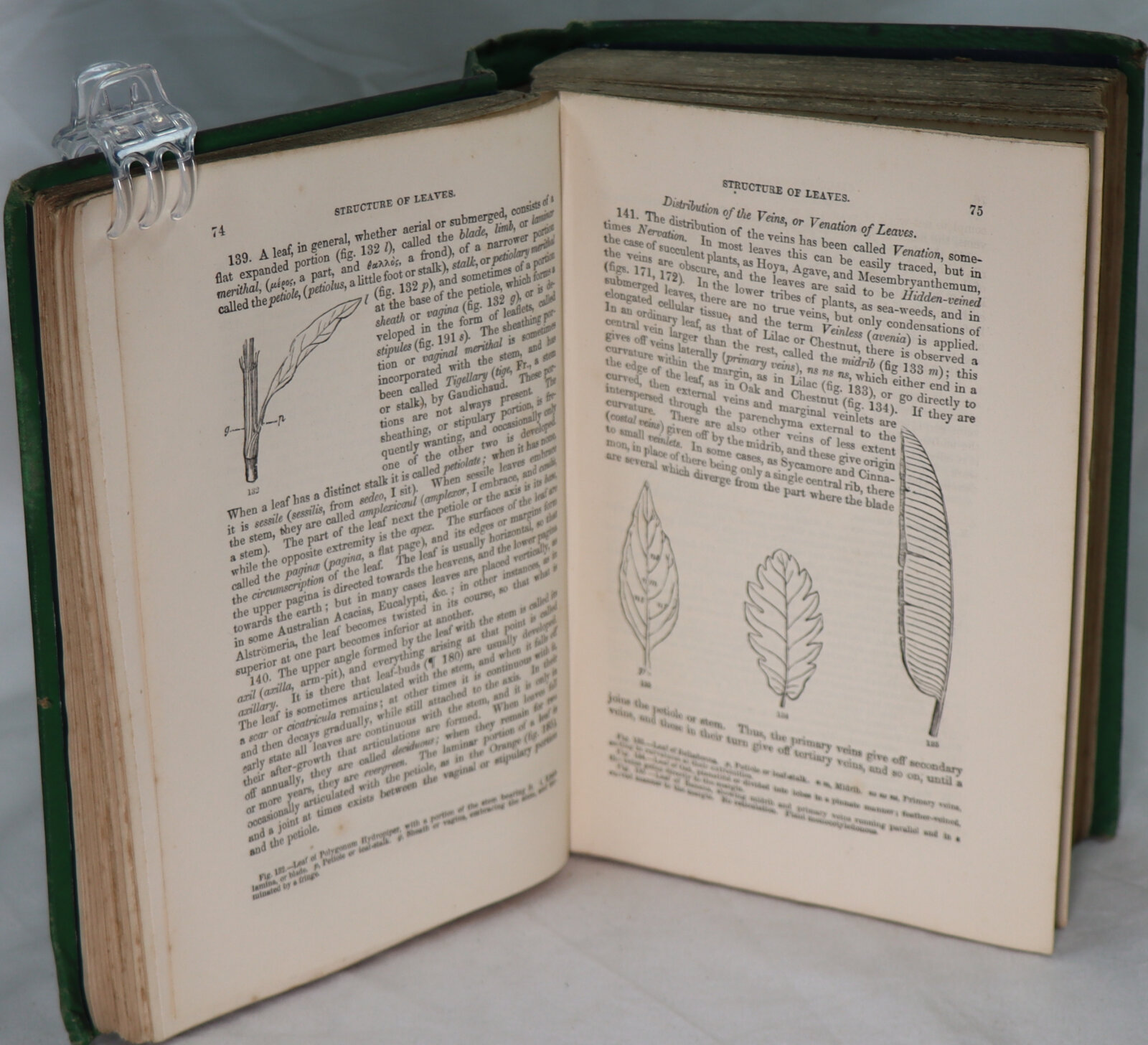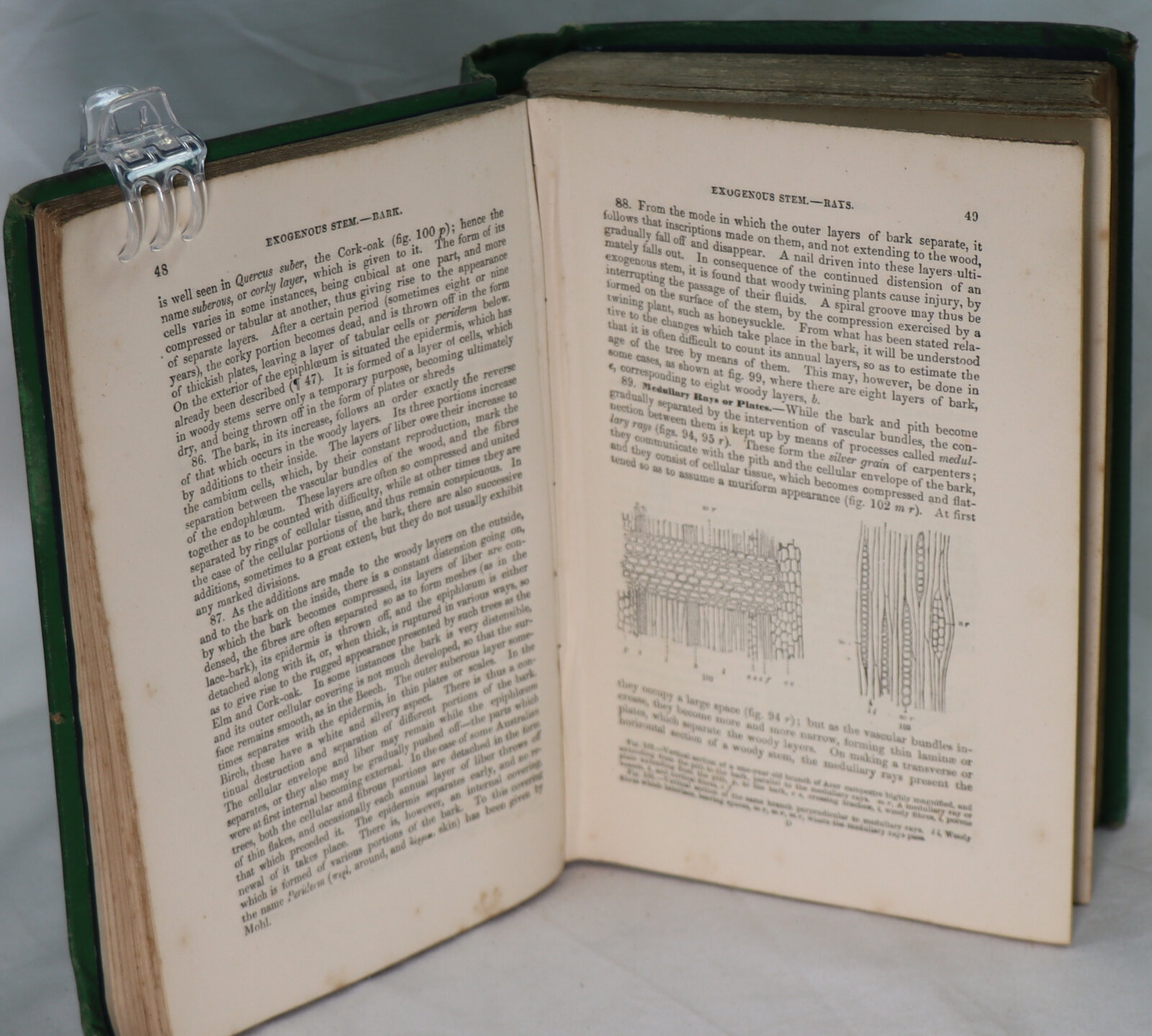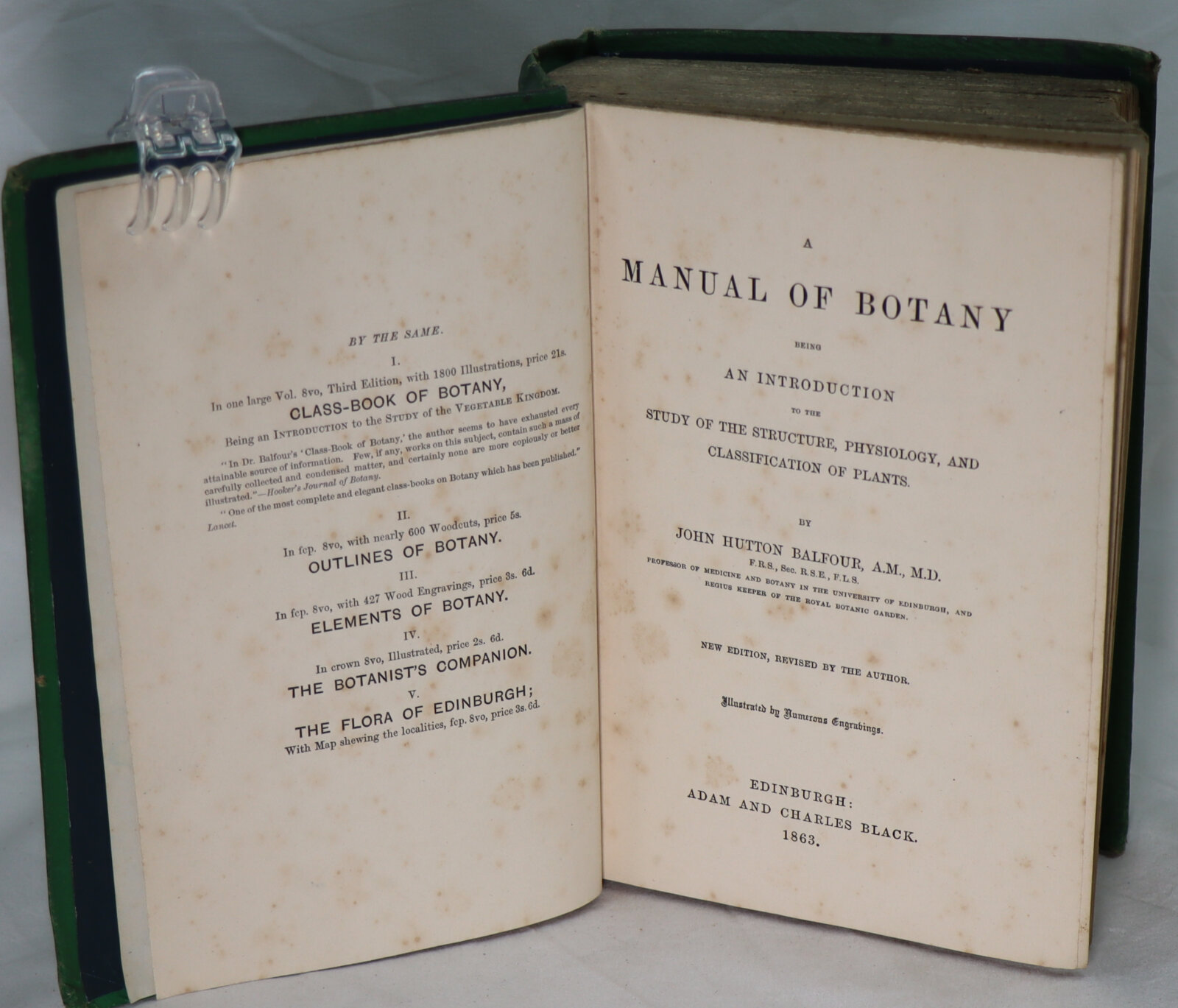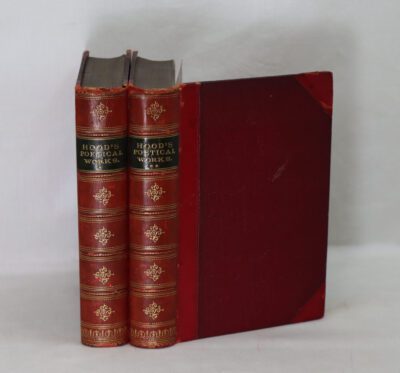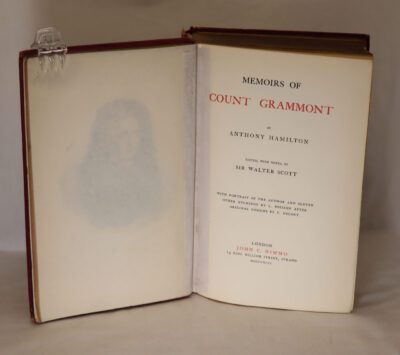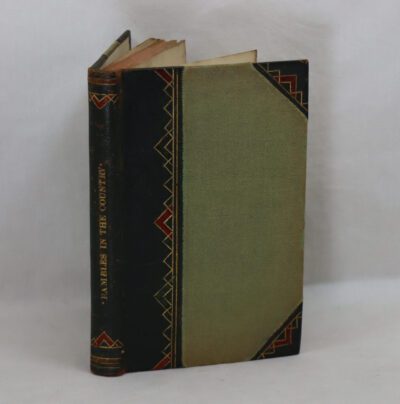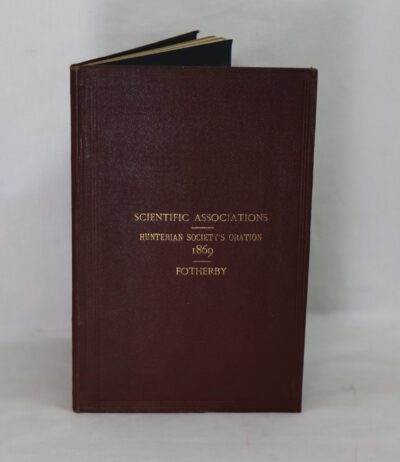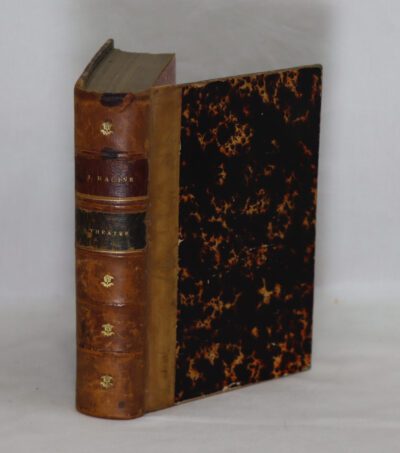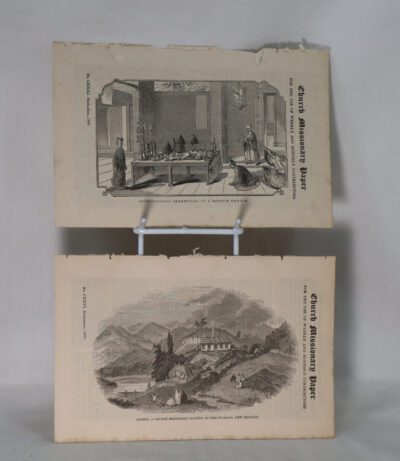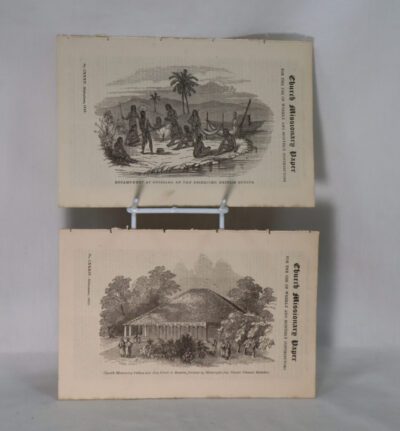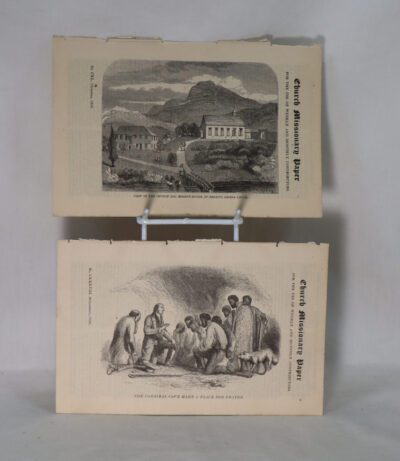The Manual of Botany.
By John Hutton Balfour
Printed: 1863
Publisher: Adam & Charles Black. Edinburgh
Edition: New edition, revised
| Dimensions | 15 × 20 × 5 cm |
|---|---|
| Language |
Language: English
Size (cminches): 15 x 20 x 5
Condition: Very good (See explanation of ratings)
Your items
Item information
Description
Green cloth binding with gilt title on the spine.
-
F.B.A. provides an in-depth photographic presentation of this item to stimulate your feeling and touch. More traditional book descriptions are immediately available.
-
Note: This book carries the £5.00 discount to those that subscribe to the F.B.A. mailing list.
New Edition, Revised by the Author. Fat 8vo. green buckram hardback with ornate gilt title to spine and blind-embossed decoration to boards. 703pp. plus5pp. Advertisements at end. Illustrated with 833 line drawings and diagrams within the text.. Overall a GOOD+ COPY.
John Hutton Balfour FRSE FRS FRCSE FLS MWS (15 September 1808 – 11 February 1884) was a Scottish botanist. Balfour became a Professor of Botany, first at the University of Glasgow in 1841, moving to the University of Edinburgh and also becoming the 7th Regius Keeper of the Royal Botanic Garden Edinburgh and Her Majesty’s Botanist in 1845. He held these posts until his retirement in 1879. He was nicknamed Woody Fibre.
Early life: He was the son of Andrew Balfour, an Army Surgeon who had returned to Edinburgh to set up a printing and publishing business. Balfour was educated at the Royal High School in Edinburgh and then studied at St Andrews University and the University of Edinburgh, graduating with degrees of M.A. and then M.D., the latter in 1832. In Edinburgh, he became a notable member of the Plinian Society, where he encountered the phrenologist William A.F. Browne and entered the vigorous debates concerning natural history and theology. His original intention had been to seek ordination in the Church of Scotland but instead he started medical practice in Edinburgh in 1834 after studying abroad. In 1834 Balfour was elected a member of the Harveian Society of Edinburgh and served as President in 1852. He was elected a Fellow of the Royal Society of Edinburgh in January 1835, aged only 26. He was one of their longest serving members. He was General Secretary 1860–1879 and Vice President 1881-3.
Botany: With an interest in botany, Balfour was prominent in the foundation of both the Botanical Society of Edinburgh in 1836 (serving as President in 1845–46) and the Edinburgh Botanical Club in 1838. In 1841 he began giving lectures in Edinburgh’s extramural school on botany with some success. In 1842 he was appointed Professor of Botany at the University of Glasgow. In 1845, Balfour transferred to take the chair of Botany at the University of Edinburgh, a position he held until 1879. He was also nominated keeper of the Royal Botanic Garden in Edinburgh and Her Majesty’s Botanist. These appointments followed a protracted political struggle in which Balfour triumphed over his distinguished opponent, Joseph Dalton Hooker, a close associate of Charles Darwin. In 1846 he was elected a member of the Aesculapian Club. Balfour served for many years as dean of the faculty of medicine in the University of Edinburgh and he was an enormously successful teacher of botany, lacing his scientific lectures with theological asides, as he remained profoundly wedded to natural theology. In January 1862, he corresponded with Charles Darwin on botanical matters, recollecting their evenings together at the Plinian Society with his brother-in-law William A.F. Browne. He also corresponded with the extraordinary and irascible botanist Hewett Cottrell Watson, an early phrenologist, evolutionist and advocate of the differential development of the human cerebral hemispheres. Under Balfour’s care the Royal Botanic Garden was enlarged and improved and a palm-house, arboretum, and teaching accommodation were built. His publications include botanical text-books such as Manual of Botany (1848), Class Book of Botany (1852), Outlines of Botany (1854), Elements of Botany for Schools (1869), Botanist’s Companion (1860), Introduction to Palaeontological Botany (1872), and The Plants of Scripture. He also contributed to the article on botany in the 8th edition of Encyclopædia Britannica. Balfour retired from his academic post in 1879. His son, Sir Isaac Bayley Balfour (1853–1922), became a distinguished botanist in his own right, serving as Sherardian Professor of Botany at Oxford University from 1884 to 1888, before returning to his father’s old Chair at Edinburgh.
California’s foxtail pine is named Pinus balfouriana Balf. after him.
Later life.
From 1877 he lived in Inverleith House within the then newly extended Royal Botanic Gardens, Edinburgh in his role there as Regius Keeper. He died in Inverleith House and was buried in Warriston Cemetery with his wife Marion Spottiswood Balfour. The grave lies on the north side of the main upper east-west path, towards its western end.
Family: He married Marion Spottiswood Bayley (1828–1879) on 8 August 1848. Their children were Ada Marion Spottiswood Balfour (1850–1918), Cpt. Andrew Francis Balfour RN (1851–1906), Isaac Bayley Balfour (1853–1922), Madeline Drummond Balfour (1854–1912), John Hutton Balfour Jr (1856–1919), George Goldie Balfour (1858–1914), Margaret Eliza Balfour (1860–1932) and Harriet Penuel Balfour (1863–1942).
Balfour’s sister, Magdelene Balfour, married William A. F. Browne (1805–1885), the phrenologist and asylum reformer. Balfour was uncle to Sir Andrew Balfour specialist in tropical medicine who was the first Director of the London School of Hygiene & Tropical Medicine in 1923 and was a close friend of Sir Patrick Manson, founder of the School. According to Sir Andrew Balfour in a speech he made to the London Royal Free Hospital, School of Medicine for Women in 1928, John Hutton Balfour was often referred as ‘Woody Fibre’.
His great-great-granddaughter is actress Tilda Swinton.
The standard author abbreviation Balf. is used to indicate this person as the author when citing a botanical name.
The Edinburgh Phrenological Society was founded in 1820 by George Combe, an Edinburgh lawyer, with his physician brother Andrew Combe. The Edinburgh Society was the first and foremost phrenology grouping in Great Britain; more than forty phrenological societies followed in other parts of the British Isles. The Society’s influence was greatest over its first two decades and declined in the 1840s; the final meeting was recorded in 1870. The central concept of phrenology is that the brain is the organ of the mind and that human behavior can be usefully understood in broadly neuropsychological rather than philosophical or religious terms. Phrenologists discounted supernatural explanations and stressed the modularity of mind. The Edinburgh phrenologists also acted as midwives to evolutionary theory and inspired a renewed interest in psychiatric disorder and its moral treatment. Phrenology claimed to be scientific but is now regarded as a pseudoscience as its formal procedures did not conform to the usual standards of scientific method.
Edinburgh phrenologists included George and Andrew Combe; asylum doctor and reformer William A.F. Browne, father of James Crichton-Browne; Robert Chambers, author of the 1844 proto-Darwinian book Vestiges of the Natural History of Creation; William Ballantyne Hodgson, economist and pioneer of women’s education; astronomer John Pringle Nichol; and botanist and evolutionary thinker Hewett Cottrell Watson. Charles Darwin, a medical student in Edinburgh in 1825–7, took part in phrenological discussions at the Plinian Society and returned to Edinburgh in 1838 when formulating his concepts concerning natural selection.
Condition notes
Want to know more about this item?
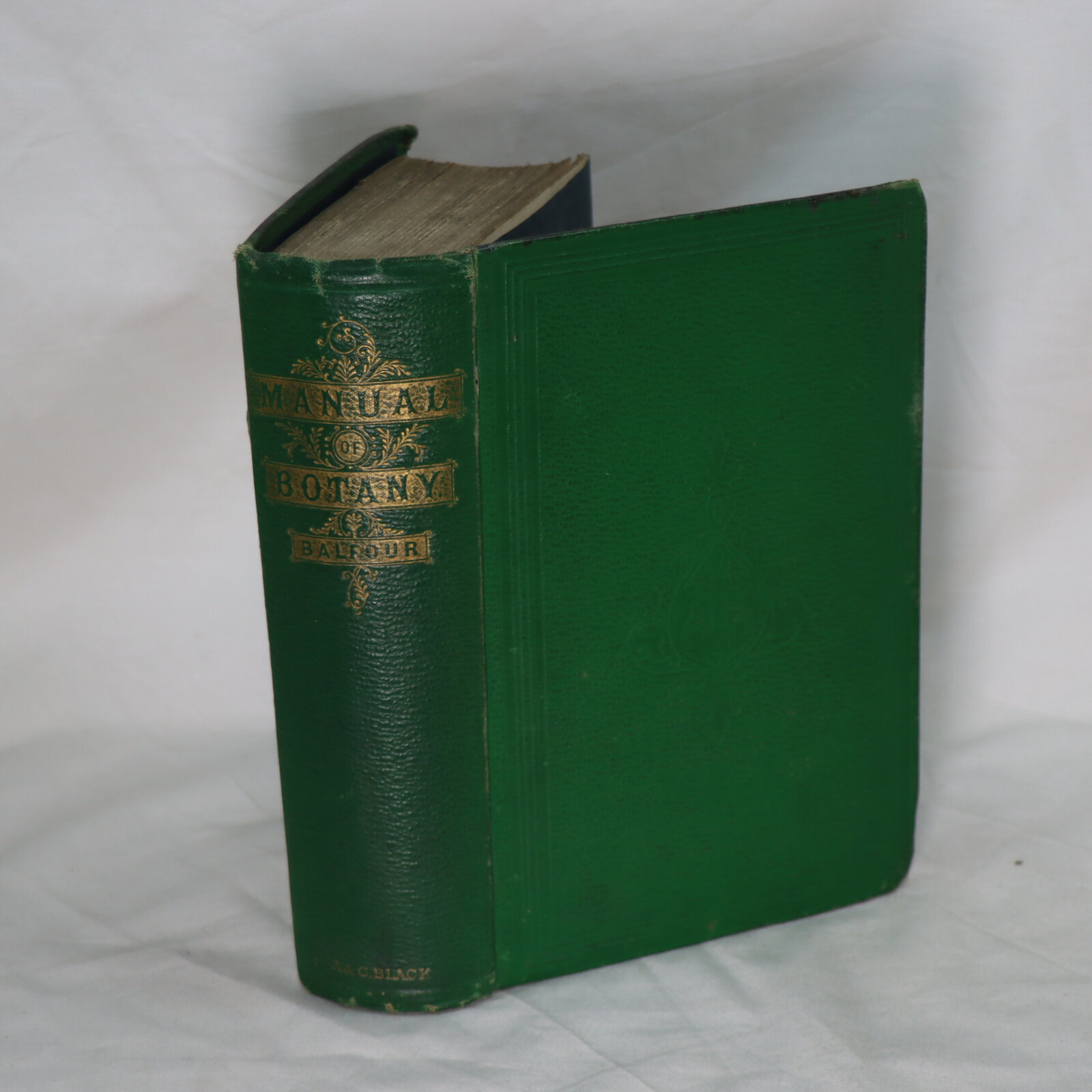
Share this Page with a friend

